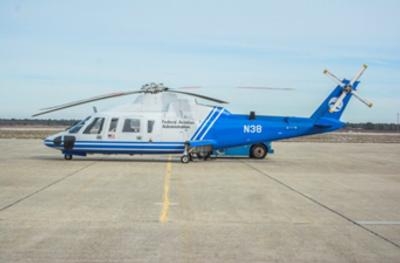Mon, Apr 10, 2017
The Research Is Being Conducted To Support Potential New Regulatory, Policy And Guidance Initiatives For Enhanced Flight Vision Systems For Helicopters
The FAA an Elbit Systems will work together to study operational concepts for the use of Enhanced Flight Vision Systems (EFVS) in helicopters. The study will help lay the foundation for the future implementation of EFVS in rotorcraft.

While EFVS rules currently exist for approaches to runways at airports, comparable regulations for EFVS do not exist for helicopters flying to onshore or offshore helipads at heliports. In addition, the unique aspects of helicopter flight and the visual cues generated require additional considerations beyond the typical Head-Up Displays (HUDs) used today.
As part of the study, Elbit Systems will install the Heli-ClearVision EFVS in the FAA’s Sikorsky S-76 helicopter to be used as the evaluation platform. The system will include several subsystems such as the revolutionary Skylens/SkyVis wearable Head Worn Display, the HeliEVS, Synthetic Vision System (SVS) and a Combined Vision System (CVS).
The study will consist of several flights to assess operational concepts and sensor characterization criteria for maintaining visual references/cues during the visual segments of instrument approach procedures and enhancing VFR (Visual Flight Rules) operations. Flights are planned to occur in different weather conditions (i.e. visibility), times of day (day, night, twilight), and via different approach types (i.e. LNAV, LPV). The results of the study will be used to evaluate the overall contribution of EFVS technology to flight safety and operational effectiveness for helicopters. Yoram Shmuely, General Manager of Elbit Systems’ Aerospace Division, said: “We are proud to cooperate with the FAA in regulating enhanced vision operation for rotorcraft. This technology will enable many lifesaving missions and will significantly increase the safety of the flying crew”.
(Source: Elbit Systems news release. FAA Image)
More News
Aero Linx: Model Aeronautical Association of Australia MAAA clubs are about fun flying, camaraderie and community. For over 75 years, the MAAA has been Australia’s largest fl>[...]
Touchdown Zone Lighting Two rows of transverse light bars located symmetrically about the runway centerline normally at 100 foot intervals. The basic system extends 3,000 feet alon>[...]
“Discovery and innovation are central to our mission at Virgin Galactic. We’re excited to build on our successful record of facilitating scientific experiments in subor>[...]
How To Get A Story On Aero-TV News/Feature Programming How do I submit a story idea or lead to Aero-TV? If you would like to submit a story idea or lead, please contact Jim Campbel>[...]
Student Pilot Reported That During Rotation, “All Of A Sudden The Back Of The Plane Kicked To The Right..." Analysis: The student pilot reported that during rotation, “>[...]
 ANN's Daily Aero-Linx (05.02.24)
ANN's Daily Aero-Linx (05.02.24) ANN's Daily Aero-Term (05.02.24): Touchdown Zone Lighting
ANN's Daily Aero-Term (05.02.24): Touchdown Zone Lighting Aero-News: Quote of the Day (05.02.24)
Aero-News: Quote of the Day (05.02.24) ANN FAQ: Contributing To Aero-TV
ANN FAQ: Contributing To Aero-TV NTSB Final Report: Cirrus Design Corp SR20
NTSB Final Report: Cirrus Design Corp SR20



